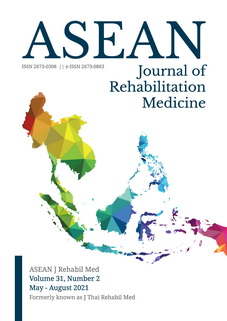Slow Reversal-Hold Technique in Treating Radial Nerve Palsy Patient: A Case Report
Keywords:
radial nerve palsy, slow reversal-hold technique, proprioceptive neuromuscular facilitation (PNF), strengthening exercise, occupational therapyAbstract
Objectives: To demonstrate the effectiveness of slow reversal-hold technique in patients with incomplete radial nerve palsy associated with humerus fracture.
Study design: Case report.
Setting: Department of Rehabilitation Medicine, King Chulalongkorn Memorial Hospital.
Subjects: A 28-year-old female patient diagnosed with fracture of upper end of left humerus subsequently developed incomplete radial nerve palsy.
Methods: Not applicable.
Results: The patient presented with wrist and finger drop and intrinsic and extrinsic wrist and finger flexors tightness of her left hand, resulting in difficulties in performing activities of daily living (ADL). Adding to conventional occupational therapy, slow reversal-hold proprioceptive neuromuscular facilitation (PNF) technique was used to treat her conditions. After 12 weeks of therapy, the aforementioned conditions resolved. Her hand function improved significantly and she eventually became totally independent in ADL.
Conclusion: Slow reversal-hold technique PNF technique combined with conservative treatment seemed to facilitate improvement of muscle power, resolving intrinsic tightness and extrinsic finger flexors shortening in a patient with incomplete radial nerve palsy.
Keywords: radial nerve palsy, slow reversal-hold technique, proprioceptive neuromuscular facilitation (PNF), strengthening exercise, occupational therapy
References
Pitts G, Umansky SC, Foister RD. Radial nerve compression. In: Saunders RJ, Burke SL, Astifidis RP, Higgins JP, McClinton MA, editors. Hand and upper extremity rehabilitation. 4th ed. London: Churchill Livingstone; 2015. p. 75-82.
Bumbasirevic M, Palibrk T, Lesic A, Atkinson H. Radial nerve palsy. EFORT open reviews. 2016;1:286-94.
Ricci FP, Barbosa RI, Elui VM, Barbieri CH, Mazzer N, Fonseca Mde C. Radial nerve injury associated with humeral shaft fracture: a retrospective study. Acta Ortop Bras. 2015;23:19-21.
Klaosuwan B. Effective techniques of physical therapy treatment for brachial plexus injured patients: a report of four cases. J Med Tech Phy Ther. 2001;13:86-93.
Sullivan PE, Markos PD. Clinical decision making in therapeutic exercise. 2nd ed. Stamford, Connecticut: Appleton & Lange; 1996.
Suzuki T, Kunishi T, Kakizaki J, Iwakura N, Takahashi J, Kuniyoshi K. Wrist extension strength required for power grip: a study using a radial nerve block model. J Hand Surg Eur. 2012;37:432-5.
Keerthi T, Dowle P, Mohan L. Effectiveness of proprioceptive neuromuscular facilitation as an adjunct to conventional therapy in conservatively managed distal radius fractures: a randomized controlled trial. Indian J Physiother Occup Ther. 2020;14:215-20.
Grinsell D, Keating CP. Peripheral nerve construction after injury: a review of clinical and experimental therapies. Biomed Res Int. 2014;2014:698256. doi: 10.1155/2014/698256
Birinci T, Razak Ozdincler A, Altun S, Kural C. A structured exercise programme combined with proprioceptive neuromuscular facilitation stretching or static stretching in posttraumatic stiffness of the elbow: a randomized controlled trial. Clin Rehabil. 2019;33: 241-52.
Sharman MJ, Cresswell AG, Riek S. Proprioceptive neuromuscular facilitation stretching: mechanisms and clinical implications. Sports Med. 2006;36:929-39.
Downloads
Published
How to Cite
Issue
Section
License
Copyright (c) 2021 ASEAN Journal of Rehabilitation Medicine

This work is licensed under a Creative Commons Attribution-NonCommercial-NoDerivatives 4.0 International License.






